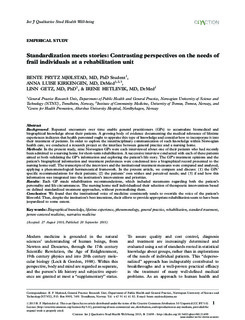Standardization meets stories: contrasting perspectives on the needs of frail individuals at a rehabilitation unit
| dc.contributor.author | Mjølstad, Bente Prytz, | |
| dc.contributor.author | Kirkengen, Anna Luise | |
| dc.contributor.author | Getz, Linn | |
| dc.contributor.author | Hetlevik, Irene | |
| dc.date.accessioned | 2015-10-08T11:05:49Z | |
| dc.date.available | 2015-10-08T11:05:49Z | |
| dc.date.issued | 2013 | |
| dc.identifier.issn | 1748-2623 | |
| dc.identifier.uri | http://hdl.handle.net/11250/2353283 | |
| dc.description.abstract | Background: Repeated encounters over time enable general practitioners (GPs) to accumulate biomedical and biographical knowledge about their patients. A growing body of evidence documenting the medical relevance of lifetime experiences indicates that health personnel ought to appraise this type of knowledge and consider how to incorporate it into their treatment of patients. In order to explore the interdisciplinary communication of such knowledge within Norwegian health care, we conducted a research project at the interface between general practice and a nursing home. Methods: In the present study, nine Norwegian GPs were each interviewed about one of their patients who had recently been admitted to a nursing home for short-term rehabilitation. A successive interview conducted with each of these patients aimed at both validating the GP’s information and exploring the patient’s life story. The GP’s treatment opinions and the patient’s biographical information and treatment preferences were condensed into a biographical record presented to the nursing home staff. The transcripts of the interviews and the institutional treatment measures were compared and analysed, applying a phenomenological–hermeneutical framework. In the present article, we compare and discuss: (1) the GPs’ specific recommendations for their patients; (2) the patients’ own wishes and perceived needs; and (3) if and how this information was integrated into the institution’s interventions and priorities. Results: Each GP made rehabilitation recommendations, which included statements regarding both the patient’s personality and life circumstances. The nursing home staff individualized their selection of therapeutic interventions based on defined standardized treatment approaches, without personalizing them. Conclusion: We found that the institutional voice of medicine consistently tends to override the voice of the patient’s lifeworld. Thus, despite the institution’s best intentions, their efforts to provide appropriate rehabilitation seem to have been jeopardized to some extent. | nb_NO |
| dc.language.iso | eng | nb_NO |
| dc.publisher | Co-Action Publishing | nb_NO |
| dc.rights | Creative Commons Attribution 3.0 Unported (CC BY 3.0) Licence (http://creativecommons.org/licenses/by/3.0/), permitting all non-commercial use, distribution, and reproduction in any medium, provided the original work is properly cited. | |
| dc.rights.uri | http://creativecommons.org/licenses/by/3.0/ | |
| dc.subject | Biographical knowledge, lifetime experience, phenomenology, general practice, rehabilitation, standard treatment, person-centered medicine, narrative medicine | nb_NO |
| dc.title | Standardization meets stories: contrasting perspectives on the needs of frail individuals at a rehabilitation unit | nb_NO |
| dc.type | Journal article | nb_NO |
| dc.type | Peer reviewed | en_GB |
| dc.rights.holder | © 2013 B. P. Mjølstad et al. | |
| dc.source.pagenumber | 21498- | nb_NO |
| dc.source.volume | 8 | nb_NO |
| dc.source.journal | International Journal of Qualitative Studies on Health and Well-being | nb_NO |
| dc.identifier.doi | 10.3402/qhw.v8i0.21498 |
Files in this item
This item appears in the following Collection(s)
Except where otherwise noted, this item's license is described as Creative Commons Attribution 3.0 Unported (CC BY 3.0) Licence (http://creativecommons.org/licenses/by/3.0/), permitting all non-commercial use, distribution, and reproduction in any medium, provided the original work is properly cited.

